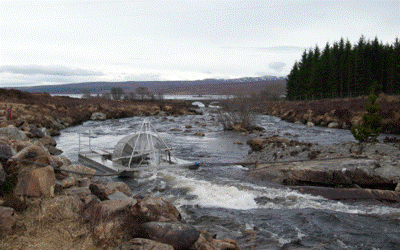The Kingie smolts trap was taken out of operation at the start of last week due to low flows which meant we could no longer keep the trap turning (new traps have an option of a motor to keep them turning in the absence of sufficient flow, which would have been handy). Yesterday the trap was removed and everything tidied up
Here are a few facts and figures from the River Kingie rotary screw trap 2024:
– Number smolts caught – 989
-number salmon parr caught – 74
– Number trout caught – 52
-Ave length of salmon smolts – 116mm (range 90 to 148mm)
-9.2% of the smolts were >130mm (size suitable for standard Acoustic Tagging)
– 145 smolts were marked and released upstream
– 52 marked smolts were recaptured (35.8%)
– 86% of the smolts were recaptured in days 1 & 2 after release
– Smolts run estimate 2,724 +/- 595.
– 842 of the smolts captured were released below Invergarry Dam, either into the upper reaches of the River Garry, or River Oich.
Overall this was a successful first year at trapping and managing smolts from the River Kingie, the largest and most important of the Upper Garry tributaries accessible to salmon.
It was a wet April but apart from one day when we could not access the trap due to the height of the river, the trap was manageable, and quite secure, even in high flows. Low water was a challenge but with management of the flow we managed to keep the trap turning most of the time.
A habitat survey of the River Kingie (2004) had concluded that the area of accessible, and suitable, habitat upstream of the smolt trap was 95,000m2. Using the standard figure of 5 smolts per 100m2, the smolt productivity of the Kingie should be in the order of 4,752 smolts. Our estimate of the run this year was around 57% of the theoretical smolt productivity, but that is considered okay for a recovering river.
DNA samples were taken from 50 smolts for screening to establish which were of stocked origin. The trapping and trucking was quite feasible and is probably one of the most helpful things that could be done to help conserve the upper Garry salmon population. We will look at opportunities for expanding this in future years, with the ultimate aim of trapping and trucking the entire run. This would need to be combined with PIT tagging, or similar, in order to establish its effectiveness.

